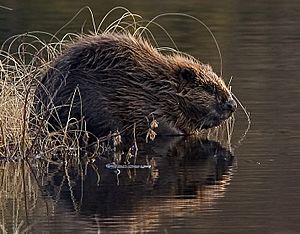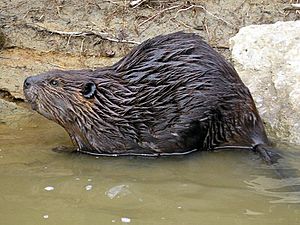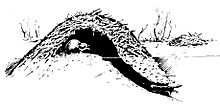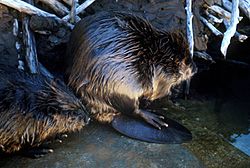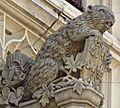Beaver facts for kids
Quick facts for kids BeaversTemporal range: Late Miocene - Recent
|
|
|---|---|
 |
|
| American Beaver | |
| Scientific classification | |
| Kingdom: | |
| Phylum: | |
| Class: | |
| Order: | |
| Suborder: | |
| Family: | |
| Genus: |
Castor
Linnaeus, 1758
|
| Species | |
|
American Beaver, C. canadensis |
|
A beaver is a kind of rodent. It is semi-aquatic, meaning it lives part of its life in water and part on land. Beavers can be found in North America and Europe. In Europe, they almost disappeared (became extinct), but they are now making a comeback. You can find beavers living in rivers like the Elbe and Rhone, and in places like Bavaria, Poland, and Scandinavia. Beavers are famous for building and taking care of dams in rivers.
Contents
Amazing Beaver Builders
Beavers are known for their amazing building skills. They construct dams across rivers and streams. They also build their homes, called "lodges," in the ponds that form behind these dams. Beavers even dig canals to move building materials that are too heavy to carry over land.
They use their strong front teeth to cut down trees and other plants. These plants are used for both building and food. If there isn't a pond already, beavers first build a dam. They start by placing vertical poles, then fill the spaces with crisscrossing branches. They pack mud and weeds into the gaps until the dam holds enough water to surround their lodge.
Beavers are slow on land, but they are excellent swimmers. They can stay underwater for up to 15 minutes!
Beaver Senses and Diet
Beavers have webbed back feet and a wide, scaly tail. Their eyesight isn't great, but they have excellent hearing, smell, and touch. A beaver's teeth never stop growing. This means they won't wear down from all the chewing they do on wood. Their four front teeth (incisors) have hard orange enamel on the front and softer material on the back. This design keeps their teeth sharp, like chisels.
Beavers are herbivores, meaning they only eat plants. They especially like the wood from quaking aspen, cottonwood, willow, alder, birch, maple, and cherry trees. They also eat sedges, pondweed, and water lilies.
Beavers do not hibernate (sleep through the winter). Instead, they store piles of sticks and logs in their ponds. They eat the soft inner bark from these stored branches. The snow that collects on top of these piles often keeps the water from freezing around the food. This gives beavers a place to breathe when they are outside their lodge in winter.
Beavers keep growing throughout their lives. Adult beavers can weigh over 25 kg (55 lb). Female beavers are often as large as or larger than males of the same age, which is unusual for mammals. In the wild, beavers can live for up to 24 years.
Types of Beavers
Today, there are two main types of beavers: the Eurasian beaver and the North American beaver.
Eurasian Beaver
The Eurasian beaver (Castor fiber) was almost hunted to extinction in Europe. People hunted them for their fur and for a substance called castoreum, which comes from their scent glands. Castoreum was once thought to have medicinal uses.
However, Eurasian beavers are now being brought back to many parts of Europe. Thousands live on the Elbe and Rhône rivers, and in parts of Scandinavia. There's a growing group in northeast Poland. They have also been reintroduced in places like Scotland, Bavaria, Austria, and the Netherlands.
North American Beaver
The North American beaver (Castor canadensis) is also called the Canadian beaver or American beaver. It is native to Canada, much of the United States, and parts of northern Mexico. This species has also been introduced to places like Argentina, Chile, Finland, France, Poland, and Russia.
North American beavers prefer the inner bark of aspen and poplar trees. They also eat birch, maple, willow, and other trees. They will eat cattails, water lilies, and other water plants, especially in early spring. Beavers do not eat fish.
These animals were often trapped for their fur. In the early 1800s, trapping caused beavers to disappear from many areas where they used to live. Beaver furs were used to make clothing and tall hats. The search for beaver fur was a big reason for early exploration in North America.
Native peoples and early settlers also ate beaver meat. Thanks to efforts to move beavers to new areas and protect their homes, their population made a great recovery by the 1940s. Today, there are an estimated 10 to 15 million beavers. Some estimates suggest there might have once been as many as 90 million!
Beaver Homes and Habitats
Beavers live in areas along rivers and streams, called riparian zones. For hundreds of thousands of years, beavers have helped keep these watery places healthy. Beavers are considered a keystone species. This means they are very important to their ecosystem because they create wetlands that many other animals use. Besides humans, no other animal changes its environment as much as a beaver does.
Beavers cut down trees for several reasons. They fell large trees to form the base of their dams. They also cut down smaller trees, especially young ones, for food. When broadleaf trees are cut, they often grow back from the stump (called coppice), providing easy-to-reach food in later years. Beaver ponds can also kill some trees by drowning them. However, these dead trees provide important homes for many other animals and plants.
Beaver Dams
Beaver dams are built to protect beavers from predators like coyotes, wolves, and bears. They also provide easy access to food during winter. Beavers always work at night. They are very busy builders, carrying mud and stones with their front paws and timber with their teeth.
It's hard to destroy a beaver dam without also removing the beavers. This is because beavers can rebuild their main dams overnight. Beavers might build a series of dams along a river.
Beaver Lodges
The ponds created by well-built dams help keep the beavers' homes, called lodges, safe. Lodges are made from cut branches and mud. Beavers cover their lodges with fresh mud each autumn. This mud freezes solid when winter comes, making the lodge almost as hard as stone. This prevents animals like wolves and wolverines from breaking in.
The lodge has underwater entrances, which makes it very difficult for other animals to get inside. Only a small part of the lodge is actually used as a living area. Beavers dig out their dens with underwater entrances after they finish building the dams and lodge structures. There are usually two dens inside the lodge: one for drying off after leaving the water, and another drier one where the family lives.
Beaver lodges are built with the same materials as dams, but they don't have a strict order. They usually house no more than four adult beavers and six to eight young ones. Some larger lodges might have partitions, which are just parts of the main structure left by the builders to support the roof. The dens usually only connect to each other through the water.
When the ice melts in spring, beavers often leave their lodges and explore. They return to their old lodges just before autumn to gather wood for winter. They usually don't start repairing their lodges until the first frost, and they rarely finish the outer mud coating until it gets very cold. When they build a new lodge, they cut the wood in early summer but usually don't start building until late August.
Beavers and Water Quality
Beaver ponds and the wetlands that form around them help clean waterways. They remove dirt and pollutants like suspended solids, nitrogen, phosphates, carbon, and silicates from the water.
You might hear the term "beaver fever." This name was made up by the American press in the 1970s. It came from finding a parasite called Giardia lamblia (which causes Giardiasis) in beavers. However, later research showed that many animals and birds carry this parasite. The main source of water contamination is usually other humans. For example, Norway has many beavers but has not had giardia outbreaks, and New Zealand has giardia but no beavers. Recent studies suggest that farm animals can also be a big source of giardia. Beaver ponds have even been shown to reduce bacteria from grazing cattle in streams, as the bacteria get trapped in the bottom sediments.
Beavers in Cities
Beavers were almost completely trapped out of New York City by the early 1800s. After 200 years, a beaver has returned to New York City, making its home along the Bronx River.
In Chicago, several beavers have come back and made a home near Lincoln Park's North Pond. However, the Chicago Park District and the Lincoln Park Conservancy were worried about damage to trees in the area.
Outside San Francisco, in downtown Martinez, California, a male and female beaver arrived in Alhambra Creek in 2006. The Martinez beavers built a dam 30 feet wide and at one point 6 feet high. They chewed through many willow trees and other plants the city had planted. When the city council wanted to remove the beavers because of flood concerns, local residents formed a group called "Worth a Dam" to protect them.
Beavers as an Introduced Species
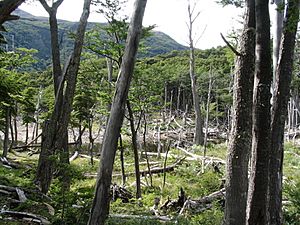
In the 1940s, beavers were brought from Canada to the island of Tierra del Fuego in southern Chile and Argentina. The idea was to raise them for their fur. However, the project failed, and ten pairs of beavers were released into the wild. Since they had no natural predators in their new home, they quickly spread across the island and to other nearby islands. Their population grew to 100,000 in just 50 years.
Now, they are considered a serious invasive species in the region. They cause a lot of damage by destroying forest trees. Efforts are being made to remove them. The ecosystem there is very different from the beavers' native home, so the ponds they create don't serve the same ecological purpose. There are also no large native predators to control their numbers. Beavers have even been found crossing salt water to islands further north, which worries naturalists who fear they might reach the mainland.
Beaver Family Life
Beavers live in families. A family usually includes an adult male and female, who mate for life, along with their young kits and yearlings (one-year-olds). Beaver families can have up to ten members. Larger families might build more lodges, while smaller families usually need only one. However, some large families in colder regions have been known to live in a single lodge.
If one beaver's mate dies, it will find another partner. Both the male and female beaver help raise their young. They also mark and defend their territory, and work together to build and repair the dam and lodge. When baby beavers are born, they stay in the lodge for their first month. Their mother is the main caregiver, while their father protects the territory.
After leaving the lodge for the first time, young beavers help their parents build food piles in the fall and repair dams and lodges. However, the adults do most of the work. Young beavers help their parents because they depend on them for food and to learn important life skills. Young beavers spend most of their time playing, but they also copy what their parents do. While copying helps them learn, they don't do the tasks as well as the adults.
Older offspring, around two years old, might also stay with their families and help. Besides helping with food piles and dam repairs, two-year-olds will also help feed, groom, and guard younger siblings. Beavers also practice alloparental care. This means an older sibling might take over parenting duties if the original parents die or are separated from them. This behavior is common in many animal species.
While these helping two-year-olds increase the chances of survival for younger beavers, they are not always essential for the family. Two-year-olds usually only stay and help if there is a shortage of food, a high population, or a drought. When beavers leave their birth territories, they usually don't go far. Beavers can recognize their relatives by smelling differences in their scent gland secretions. Related beavers have more similar scent profiles than unrelated beavers. Being able to recognize family is important for beaver social behavior, as it leads to more tolerant behavior among neighboring beavers.
Beaver Territories
Beavers create and protect their territories, which are areas for feeding, nesting, and mating. They put a lot of effort into their territories, building dams and learning the area well. Beavers mark their territories by building "scent mounts." These are piles of mud, debris, and a special scent called castoreum, which comes from glands near their tail. These scent mounts are placed along the edge of their territory.
If a beaver smells another beaver's scent in its territory, finding the intruder becomes its top priority, even over food. Because they invest so much energy in their territories, beavers don't like intruders. The beaver that owns the territory is more likely to become aggressive. These encounters can be violent. To avoid fights, a beaver marks its territory with as many scent mounds as possible. This tells intruders that the territory owner is strong enough to defend its home. So, territories with more scent mounts are avoided more often. Scent marking increases in August when young beavers are leaving their families, to try and stop them from entering other territories.
Beavers also show a behavior called the "dear enemy effect". A beaver that owns a territory will investigate and get to know the scents of its neighbors. Because of this, they react less aggressively to their neighbors entering their territory than to strangers.
However, there have been reports of beaver aggression towards humans. In April 2013, a fisherman in Belarus died after being bitten twice on the leg by a wild Eurasian beaver.
Beavers and People
Commercial Uses
European beavers were hunted almost to extinction partly for a substance called castoreum. This was used in medicine as a pain reliever and to reduce swelling and fever. Castoreum is still used today in perfumes.
Castoreum can also be used to enhance the flavors of vanilla, strawberry, and raspberry. It is sometimes added to frozen dairy products, jellies, candy, and fruit drinks. However, because it is difficult and expensive to get, it is very rarely used in common food products.
In the American state of Arkansas, beaver tail stew is eaten in a town called Cotton.
The search for beaver fur was very important in the early exploration and trade of Canada. The most valuable part of the beaver was its soft inner fur. Its tiny barbs made it excellent for making felt, especially for hats. In Canada, a "made beaver" or castor gras (a pelt that a Native person had worn or slept on) was more valuable than a fresh skin. This was because wearing it helped remove the coarser outer guard hairs.
Trapping Beavers
Beavers have been trapped for thousands of years, and this continues today. Beaver pelts were used for barter by Native Americans in the 17th century to trade for European goods. The pelts were then sent to Great Britain and France to be made into clothing. Widespread hunting and trapping led to beavers becoming endangered.
Eventually, the fur trade declined because there was less demand in Europe. Also, trapping grounds were taken over for farming. A small increase in beaver trapping has happened in some areas where there are too many beavers. Trapping is done when the fur is valuable, and the rest of the animal might be used as feed. In the 1976/1977 season, 500,000 beaver pelts were harvested in North America.
Beavers in Culture

In wider culture, the beaver is famous for being hardworking and skilled at building. The English verb "to beaver" means to work very hard and constantly.
The name Beverly or Beverley, found in many places and used as a first name, comes from Old English words meaning "beaver" and "clearing."
Beavers are featured in popular culture:
- The show Happy Tree Friends has beaver characters named Toothy and Handy.
- The animated Nickelodeon show The Angry Beavers features Daggett and Norbert.
- The anthropomorphic Mr. and Mrs. Beaver play an important role in The Lion, the Witch and the Wardrobe, the first part of C.S.Lewis' The Chronicles of Narnia.
National Emblem
The beaver's importance in Canada's history, especially through the fur trade, led to it being named the national animal in 1975. The animal has long been connected with Canada. It appeared on the coat of arms of the Hudson's Bay Company in 1678. It is shown on the Canadian five-cent coin and was on the first picture postage stamp issued in the Canadian colonies in 1849 (the "Three-Penny Beaver").
As a national symbol, the beaver was chosen as the mascot for the 1976 Summer Olympics held in Montreal. Its name was "Amik" ("beaver" in the Ojibwe language). The beaver is also a symbol for many groups and organizations within the Canadian Forces. For example, it's on the cap badges of the Royal 22e Régiment and the Canadian Military Engineers. The Toronto Police Services, London Police Service, and Canadian Pacific Railway also feature the beaver on their crest or coat of arms.
Other groups or companies that use the beaver as a symbol or mascot include:
In Dietary Law
In the 17th century, the Roman Catholic Church made a special ruling about beavers. Based on a question from the Bishop of Quebec, the Church decided that the beaver was a fish for purposes of dietary law. This meant that the general rule against eating meat on Fridays did not apply to beaver meat. This decision was likely based on the idea that an animal's classification could depend on its habits (like living in water) as much as its body. This is similar to how the Church classified other semi-aquatic rodents, such as the capybara and muskrat.
In Computer Science
In computer science, a busy beaver is a special kind of Turing machine (a theoretical computer model). It's one that performs the maximum number of steps or writes the most symbols on its tape among all similar machines. The name comes from the idea of an "industrious person."
Images for kids
-
North American beaver in Yellowstone National Park
-
Salmon (Oncorhynchus nerka) jumping a beaver dam
-
Grey Owl feeding his beaver
See also
 In Spanish: Castores para niños
In Spanish: Castores para niños


